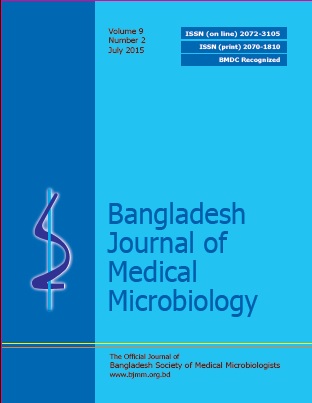Typhoidal Salmonaelle in Holy Family Red Crescent Medical College Hospital, Dhaka, Bangladesh
DOI:
https://doi.org/10.3329/bjmm.v9i2.31415Keywords:
Bangladesh, Nalidixic acid resistant, Salmonella typhi.Abstract
Enteric fever is still an important public health problem in many developing countries like Bangladesh. A changing antibiotic susceptibility pattern of Salmonella typhi and Salmonella paratyphi A and emergence of multidrug resistance has increased to a greater concern. The present study was undertaken to find out the rate of isolation of Salmonella from Blood samples and to compare the changing patterns of drug resistance at Holy Family Hospital and Medical College and Hospital over a two year study period from January 2013 to December 2014. During the period January 2013 to December 2013, total 31 Salmonella were isolated (14% of blood isolates) in which Salmonella typhi were 27 and Salmonella paratyphi were 4. Again, during the period January 2014 to December 2014, total 27 Salmonella were isolated (10% of blood isolates) in which Salmonella typhi were 23 and Salmonella paratyphi were 4. The rate of isolation of S. typhi was noted higher among pediatric group when compared to adult group in both study periods. The sensitivity of cotrimoxazole and chloramphenicol was increased which were (80-88)% & (79-93)% respectively in 2 year study period. Nalidixic acid resistant Salmonella typhi(NARST) was 88-89% and all of NARST showing good sensitivity to ciprofloxacin. In our study period, Azythromycin resistance rate is increasing from 30-35%. All the isolates were fully susceptible to 3rd generation of cephalosporin in both study periods. The rate of Multi drug resistant(MDR) was (6.5- 7.4)%; which was low in 2 year period. The policy of empirical treatment of enteric fever needs to be rationalized and newer generation antibiotics should be restricted only for multi-resistant cases of enteric fever.
Downloads
123
192

